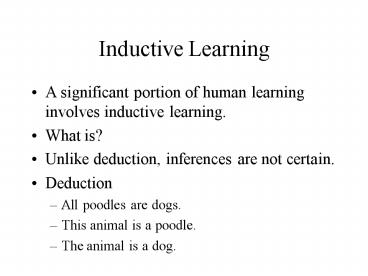Inductive Learning - PowerPoint PPT Presentation
1 / 22
Title: Inductive Learning
1
Inductive Learning
- A significant portion of human learning involves
inductive learning. - What is?
- Unlike deduction, inferences are not certain.
- Deduction
- All poodles are dogs.
- This animal is a poodle.
- The animal is a dog.
2
- Induction
- This animal wags its tail.
- This animal eats bones.
- This animal is a dog. (But, it may not be.)
- Two inductive situations
- Categorization
- Causal inference
3
Categorization
- How do we acquire concepts?
- animal, fruit, vegetable, furniture
- Concepts facilitate understanding of the world.
- A number of theories.
4
Associative view (Hull)
- We acquire concepts by associating the critical
feature with a concept. - Study
- Asked subjects to categorized Chinese characters.
- Each contained one critical feature, but subjects
were not informed. - Subjects gradually learned but were unable to
identify the critical features.
5
Hypothesis testing (Bruner)
- Acquisition is more systematic.
- We test hypotheses.
- Study
- Subjects identified instances.
- Announce the concept when they identified.
- Much more conscious process than Hull thought.
- Also, the process is not continuous.
6
But...
- Showed gradual improvement.
- Bower and Trabasso (1964)
- It is an artifact.
- Different subjects are acquiring the concepts at
different trials. - Graph - showing the percentage of subjects who
are getting it rather than each individual is
getting the concepts gradually.
7
Backward learning curve
- New way of plotting data.
- The rate of success before the trial on which
they made the last error. - No gradual improvement.
- 50/50 success rate.
- Concept acquisition is all or none.
8
Natural concepts
- But, we dont acquire natural concepts that way.
- We are not aware of critical features.
- E.g., Tomato - fruit? Vegetable? Why?
- In fact - McClosky Glucksberg (1978)
- Subjects disagreed each other.
- They changed their mind on retest (unreliable).
9
- Also, there are degrees of belongingness
- Rosch (1973)
- Some are more typical than others.
- Natural categories are fuzzy categories.
- How do we learn?
- Schema theory
- Exemplar theory
10
Schema theory
- Gluck and Bower (1988)
- Strengths of association are formed between
stimulus features and categories according to
Wagner Rescorla rule. - Also, there is a corresponding reduction in
strength for the alternative. - Instances are seen as members to the extent that
they display features associated with the
category.
11
Medin Schaffer (1978)
- 1. One large red triangle (is in category A).
- 4 A features and 0 B features.
- 2. Two small red triangles (is in category A).
- 2 A features and 2 B features
- 3. One large blue circle is (in category A).
- 2 A features and 2 B features
- 4. Two small blue circle is (in category B).
- 2 A features and 2 B features
- 5. One large red circle is (in category B).
- 3 A features and 1 B features
- 6. Two small blue circles (is in category B).
- 1 A features and 3 B features
12
- 5 should be difficult for subjects, but not
really. - Additional assumption
- Subjects use configual cues.
- red circle
13
Exemplar theory
- Medin and Schaffer (1978)
- Subjects remember some or all instances of
various categories. - So, given an instance
- determine which past instance is similar.
- if it is similar, it is an instance of the same
category.
14
Example
- Calculate similarity of component features
- Test stimulus One large blue triangle
- Retrieved One large red triangle
- Compute similarity using 0-1 scale
- Number Size Color Shape
- 1 x 1 x .2 x 1 .200
15
Which one is correct?
- Estes et al. (1989)
- Categorizing patients symptoms into a rare or
common disease. - 240 cases
- Compared predictions made by the models and
subjects performance. - Both models fared well.
16
Causal inferences
- How to make causal inferences?
- Animals do it in conditioning.
- We use a number of cues
- Statistical cues
- Spatial and temporal cues
- Kinematic cues
17
Statistical cues
- Subjects are sensitive to statistical contingency
18
Anderson Sheu (1994)
- But, they do not place equal weight to all the
cells. - So, they were not computing complete
probabilities - P(EC) a/ab P(EC) c/cd
- But, majority were. Minority ignored c d.
19
Spatial and temporal cues
- Which is more important?
- Spatial or temporal
- Depending on the situations
- Bullock et al. (1982)
- jack-in-the-box paradigm
- two balls
- closer in space or closer in time
- 70 - relied on closer in space
20
Not always.
- Anderson (1991)
- Varied time and distance
- Distance was important when time was short.
- More delay - no effect of distance
- Why the difference?
- Subjects actually think about the mechanism.
- Long delay with short distance?
- Unlikely the cause
21
Kinematic cues
- Movement of objects
- One object hits the other.
- Subjects are very sensitive to how one object
affects the movement of the other. - But, subjects make errors.
22
Kaiser et al. (1985, 1986)
- How does a ball roll off a table?
- Errors
- straight down
- L-shapded
- How does a ball roll out of a curved tube?
- Error
- curved trajactory































